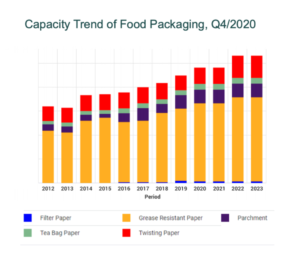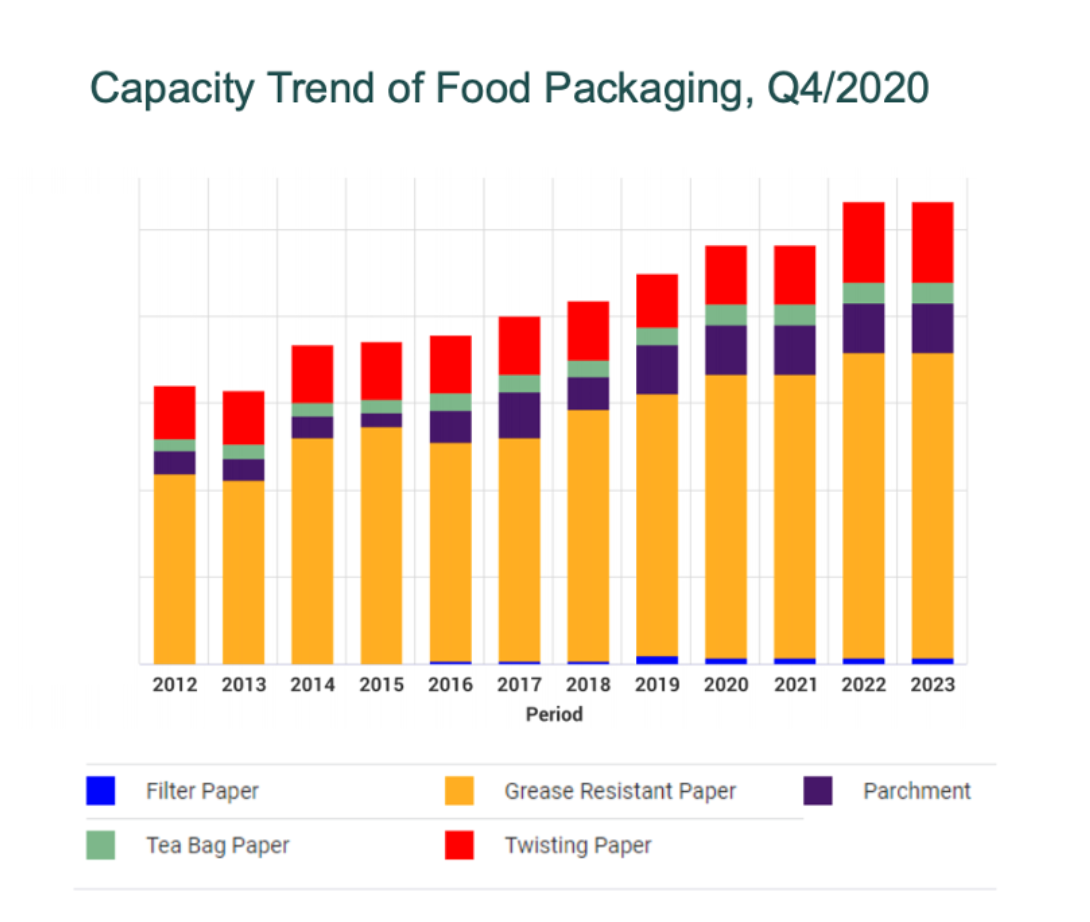As my colleague from Fisher International, Pirita Huotari, pointed out on her recent blog post, ‘Is Fiber-Based Food Packaging a New Golden Opportunity for Specialty Papers?’, several major food corporations like McDonalds are making the commitment to transition to 100% fibre-based packaging by 2025, which presents a whole range of new opportunities for the Pulp & Paper industry. Recent announcements, among others, also include KFC’s fibre-based sporks; Diageo’s paper-based Johnnie Walker bottle that is expected to debut next year; and the Paper Bottle project with participation from branded companies such as Carlsberg Group, L’Oreal, Absolut company and Coca-Cola Europe.
According to Pirita, the production capacity of paper food packaging in Europe has been trending higher annually since 2013. While many plastics can technically be recycled, some plastic types are more difficult to recycle and biodegradability remains problematic, which is the perfect opportunity for the paper industry to present substitute alternatives.
While these are great opportunities for both the environment and the P&P industry, there are still relatively large barriers to be overcome, which will slow the implementation of these technologies at scale. In order to be a successful substitution, fibre-based packaging needs to outperform the competition and be cost-competitive, and many companies are currently developing strategies, products, prototypes, etc.
 Pirita from Fisher International and Andreas Engelhardt, synthetic fibres senior consultant at Tecnon OrbiChem, will be speaking at the 2nd International Virtual Conference on Cellulose Fibres to be held on 2-3 February 2021 organized by nova-Institute.
Pirita from Fisher International and Andreas Engelhardt, synthetic fibres senior consultant at Tecnon OrbiChem, will be speaking at the 2nd International Virtual Conference on Cellulose Fibres to be held on 2-3 February 2021 organized by nova-Institute.
nova also recently announced its six nominees below for its 2021 Cellulose Fibre Innovation of the Year award where the winner will be announced during the conference. The innovation award will be granted to the innovative cellulose fibre industry for the development of new technologies and applications.
Bast Fibre Tech (Canada): Compostable fibre products from agricultural hemp and flax waste
BFTi produces compostable fibre products out of agricultural waste from hemp and flax processing. Using biogenic waste from the production of fast-growing crops instead of using wood or fossil resources is environmentally and economically more sustainable. Applications for the obtained fibre with moisture-absorbing properties are for example toilet paper and recyclable, thus flushable cleaning wipes. More information: www.bastfibretech.com
Empa – Laboratories for Materials Science and Technology (Switzerland): Cellulose nanofiber assisted biomimetic aerogels for EMI shielding
Empa researchers combined cellulose-based aerogels with silver nanowires. The flexible composite blocks high-frequency electromagnetic radiation, which is traditionally achieved by using inflexible metal sheets or metallized foils. This ultra-light electromagnetic shielding material can be used to protect electronic components or the transmission of signals from electromagnetic fields caused by neighbouring electronic devices or motors. More information: www.empa.ch/web/s604/cellulose-emi-shielding
Kelheim Fibres (Germany): Plastic-free absorbent hygiene products
Kelheim Fibres developed plant-based fibre solutions for absorbent hygiene products. These comprise speciality fibres for the single layers of AHP with different functionalities: a hydrophobized fibre for the top sheet, a trilobal fibre for the acquisition/distribution layer and a hollow fibre for the absorbent core. These biodegradable and sustainably manufactured fibres enable the replacement of plastic fibres without a loss of performance. The material has the potential to be used also for the production of textiles, such as reusable menstrual underwear. First commercial end-products using Kelheim’s fibre solutions are developed and intended to be launched in 2021. More information: www.kelheim-fibres.com
Metsä Spring (Finland): Textile fibre based on paper‑grade pulp
The Metsä Group is developing a more energy-efficient process based on a new solvent family to produce Man-Made Cellulosic Fibre (MMCF). Using ionic liquids, the MMCF can be produced from paper-grade pulp, avoiding the use of energy-intensive dissolving pulp. MMCF, such as viscose, lyocell or ModalÒ, are important fibres for the textile industry. More information: www.metsaspring.com/project/textile-fibre-from-paper-grade-pulp/
OrganicDisposables (Poland): FibriTech – a porous and light material from cellulose for soilless farming
FibriTech is a new process for the production of porous and light material from cellulose and lignocellulose. A mixture of fibres can be used, including waste and recycled fibres. This extends the possible feedstock for usable materials and reduces waste. Desired properties are derived by the application of bio-additives. The resulting material can be used as a natural soilless substrate with favourable properties for both plants and soilless farming systems. Other possible applications are thermal and sound insulators and air filters. More information: www.fibri.tech
Stora Enso (Sweden): Cellulose-based Foam by Stora Enso – a lightweight cellulose-based foam for packaging
“Cellulose-based Foam by Stora Enso” is a lightweight foam material made from cellulose. It is designed as an eco-friendly alternative for fossil-based packaging and cushioning materials such as expanded polystyrene or polyethylene. The foam has comparable shock-absorbing and insulating properties whilst being bio-based, biodegradable, compostable and recyclable in ordinary paper recycling. More information: www.cellutech.se/cellulose-based-foam.html




